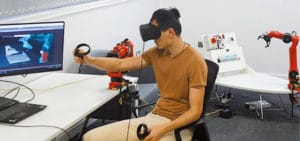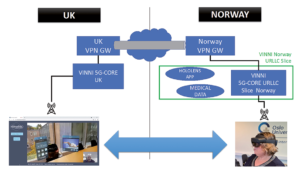5G-VINNI XR use cases from the UK
The UK facility of Horizon 2020 project 5G-VINNI provides an ideal testing ground for extended reality experimentation. From the UK facility, based at BT’s Adastral Park research centre, we have been able to explore XR use cases for remote robotic control and for public exhibitions. In addition, a high-speed VPN link from the UK to the Norway facility of 5G-VINNI has enabled us to demonstrate a cross-facility, remote paramedic experiment using the 5G capabilities of both facilities.
5G-VINNI testbed in the UK
The three-year Horizon 2020 project 5G-VINNI, which ended in 2021, has provided a set of interconnected 5G testbeds across Europe. The UK facility of the project is based at BT’s research centre at Adastral Park, Suffolk in the UK. Adastral Park is a large business campus comprising a number of buildings along with roads and pathways, as well as grass and wooded area – all providing an ideal testing ground for a number of XR use cases, both indoors and outdoors. The facility provides 5G radio systems at 3.6GHz and 26GHz, supported by an edge cloud compute capability (including GPU-based servers) which can host the XR applications. In addition, a high-speed VPN link from the UK to the Norway facility of 5G-VINNI allows us to explore cross-facility experiments using the 5G capabilities of both facilities.
Industry 4.0 – remote robotic control
Industry 4.0 use cases can benefit widely from the application of extended reality, particularly for industrial robotics. We conducted a remote robotic control experiment with UK company Extend Robotics running on the 5G-VINNI testbed at Adastral Park. Extend Robotics seeks to “build affordable robotic arms capable of remote operation from anywhere in the world, using cloud-based teleoperation software”.
In this experiment we have connected a robotic arm to a VR-based arm controller over the 5G-VINNI network. The arm is used to control switches and dials on an electrical panel, requiring intricate control of the arm’s movement, and can be seen in figure 1.
The robotic arm houses a series of cameras that are able to stream video images of the arm to the person controlling the arm, who wears the VR headset. The high throughput capabilities of the 5G network (typically over 300 Mbps) provide more than adequate capacity for this purpose.
We have been able to show that the controller handsets, the movement of the robotic arm, and the view in the VR headsets are able to be kept in tight synchronisation. This has been possible by utilising the low latency path through the 5G-VINNI network – typically less than 10ms.

Figure 1: Remote robotic control over the 5G-VINNI network
Augmented reality – The Green Planet
Exhibitions can be brought to life with the addition of an extended reality experience for their visitors. Early in 2022 the BBC launched a series of TV programmes – the Green Planet, hosted by David Attenborough – and along with the series opened an exhibition in central London. The exhibition provides visitors with an augmented reality experience in which they can traverse a series of plant-based biomes, guided by a David Attenborough avatar viewed through a 5G-connected smartphone. As part of the development, the AR application went through a series of user testing on the 5G-VINNI testbed. The application was able to take advantage of a number of testbed features including: a) high capacity – despite the users being positioned within a small indoor area, the testbed was able to support over twenty simultaneous users, each streaming the experience to their handsets at the same time. This provided valuable information for radio capacity planning at the London venue; and b) high bandwidth – download speeds in excess of 200 Mbps (single user) provided enough throughput for the video streaming and to be able to assess the user experience and thus provide valuable feedback to the application developers. Figure 2 shows a typical user in the exhibition, enjoying The Green Planet experience.

Figure 2: User experiencing The Green Planet over 5G (Photo by Seamus Ryan)
Cross testbed inter-working – remote paramedic
The use of extended reality applications can provide major benefits to the healthcare sector, improving patient outcomes in a number of innovative ways. One of these is in the support of a remote paramedic who attends an incident in the field and is able to communicate with a surgeon at the hospital. The paramedic wears a HoloLens headset and is able to view information provided by the surgeon. At the same time, the surgeon is able to view what the paramedic can see in his field of view on a computer at the hospital. The 5G-VINNI project was able to demonstrate this application between two of the project facilities, with the paramedic connecting to the 5G facility in Norway and the surgeon to the 5G facility in the UK. Figure 3 shows the set-up and imagery from the demonstration over 5G-VINNI.
The experiment was able to take advantage of a dedicated VPN established between the UK and Norway facilities of 5G-VINNI. Latency values of 38 ms were low enough to support smooth running of the HoloLens application, and end-to-end bandwidth performance of over 150 Mbps was more than enough to support the video streaming required.

Figure 3: Remote paramedic setup over 5G-VINNI
Conclusion
Extended reality applications need a high-performance network to be able to provide the optimum experience to users. This includes high throughput to allow content streaming to XR headsets, high capacity where a number of simultaneous XR users are in operation, and low latency where the application needs tight synchronisation between the different component parts. We have been able to show that 5G is able to support these requirements. Through the use of 5G testbeds, provided through the Horizon 2020 project 5G-VINNI, we have demonstrated how the use of XR can enrich the user experience in remote robotic control, entertainment exhibition, and remote paramedic applications.
The UK facility of Horizon 2020 project 5G-VINNI provides an ideal testing ground for extended reality experimentation. From the UK facility, based at BT’s Adastral Park research centre, we have been able to explore XR use cases for remote robotic control and for public exhibitions. In addition, a high-speed VPN link from the UK to the Norway facility of 5G-VINNI has enabled us to demonstrate a cross-facility, remote paramedic experiment using the 5G capabilities of both facilities.
5G-VINNI testbed in the UK
The three-year Horizon 2020 project 5G-VINNI, which ended in 2021, has provided a set of interconnected 5G testbeds across Europe. The UK facility of the project is based at BT’s research centre at Adastral Park, Suffolk in the UK. Adastral Park is a large business campus comprising a number of buildings along with roads and pathways, as well as grass and wooded area – all providing an ideal testing ground for a number of XR use cases, both indoors and outdoors. The facility provides 5G radio systems at 3.6GHz and 26GHz, supported by an edge cloud compute capability (including GPU-based servers) which can host the XR applications. In addition, a high-speed VPN link from the UK to the Norway facility of 5G-VINNI allows us to explore cross-facility experiments using the 5G capabilities of both facilities.
Industry 4.0 – remote robotic control
Industry 4.0 use cases can benefit widely from the application of extended reality, particularly for industrial robotics. We conducted a remote robotic control experiment with UK company Extend Robotics running on the 5G-VINNI testbed at Adastral Park. Extend Robotics seeks to “build affordable robotic arms capable of remote operation from anywhere in the world, using cloud-based teleoperation software”.
In this experiment we have connected a robotic arm to a VR-based arm controller over the 5G-VINNI network. The arm is used to control switches and dials on an electrical panel, requiring intricate control of the arm’s movement, and can be seen in figure 1.
The robotic arm houses a series of cameras that are able to stream video images of the arm to the person controlling the arm, who wears the VR headset. The high throughput capabilities of the 5G network (typically over 300 Mbps) provide more than adequate capacity for this purpose.
We have been able to show that the controller handsets, the movement of the robotic arm, and the view in the VR headsets are able to be kept in tight synchronisation. This has been possible by utilising the low latency path through the 5G-VINNI network – typically less than 10ms.
Augmented reality – The Green Planet
Exhibitions can be brought to life with the addition of an extended reality experience for their visitors. Early in 2022 the BBC launched a series of TV programmes – the Green Planet, hosted by David Attenborough – and along with the series opened an exhibition in central London. The exhibition provides visitors with an augmented reality experience in which they can traverse a series of plant-based biomes, guided by a David Attenborough avatar viewed through a 5G-connected smartphone. As part of the development, the AR application went through a series of user testing on the 5G-VINNI testbed. The application was able to take advantage of a number of testbed features including: a) high capacity – despite the users being positioned within a small indoor area, the testbed was able to support over twenty simultaneous users, each streaming the experience to their handsets at the same time. This provided valuable information for radio capacity planning at the London venue; and b) high bandwidth – download speeds in excess of 200 Mbps (single user) provided enough throughput for the video streaming and to be able to assess the user experience and thus provide valuable feedback to the application developers. Figure 2 shows a typical user in the exhibition, enjoying The Green Planet experience.
Cross testbed inter-working – remote paramedic
The use of extended reality applications can provide major benefits to the healthcare sector, improving patient outcomes in a number of innovative ways. One of these is in the support of a remote paramedic who attends an incident in the field and is able to communicate with a surgeon at the hospital. The paramedic wears a HoloLens headset and is able to view information provided by the surgeon. At the same time, the surgeon is able to view what the paramedic can see in his field of view on a computer at the hospital. The 5G-VINNI project was able to demonstrate this application between two of the project facilities, with the paramedic connecting to the 5G facility in Norway and the surgeon to the 5G facility in the UK. Figure 3 shows the set-up and imagery from the demonstration over 5G-VINNI.
The experiment was able to take advantage of a dedicated VPN established between the UK and Norway facilities of 5G-VINNI. Latency values of 38 ms were low enough to support smooth running of the HoloLens application, and end-to-end bandwidth performance of over 150 Mbps was more than enough to support the video streaming required.
Conclusion
Extended reality applications need a high-performance network to be able to provide the optimum experience to users. This includes high throughput to allow content streaming to XR headsets, high capacity where a number of simultaneous XR users are in operation, and low latency where the application needs tight synchronisation between the different component parts. We have been able to show that 5G is able to support these requirements. Through the use of 5G testbeds, provided through the Horizon 2020 project 5G-VINNI, we have demonstrated how the use of XR can enrich the user experience in remote robotic control, entertainment exhibition, and remote paramedic applications.
Further information
- 5G-VINNI project website – http://www.5g-vinni.eu
- Extend Robotics website –http://www.extendrobotics.com
- The Green Planet –https://thegreenplanetexperience.co.uk
